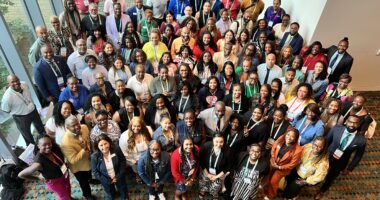Women in Leadership: Find Your It Factor
Two female administrators discuss how nature versus nurture, overcoming barriers, and being a change agent all played into their confidence to grow as school leaders.

Did you ever wonder what traits made someone an “It girl?” Why is it that certain female colleagues seem to get ahead, almost like there is a ray of light beckoning them to success?
It might be easy to assume that some people move ahead because of their connections, or because they are unscrupulous. But perhaps it is because they really know themselves. Think about it: When we see other women gaining momentum or advancing in their careers, what is it they all have in common? The “It factor” is confidence. This may seem like an oversimplified answer, but confidence may not be so cut and dry. And it can have an impact on the risks we take as well as the opportunities we miss.
In 2019, Macy Bayern wrote Why Risk-Taking Is Vital for Women to Become Leaders in the Workplace. Based on a KPMG Women’s Leadership Study in the same year, Bayern analyzed the findings that pinpointed the effect confidence has on women’s mindsets and career advancement. The study recommended these steps to help women build confidence in the workplace:
- Make a conscious effort to as for what you want, and be clear in those wants;
- Stay aware of the impression you make, and be strong in that impression;
- Speak up and defend your position; and
- Take risks (no risks means no reward).
KPMG also reported that almost half the female employees surveyed attributed the risk-taking they took to their level of confidence. Meanwhile, roughly 40 percent of women stated that they did not take risks at work because they lacked confidence.
Confidence and COVID-19
Since March 2020, the pandemic has affected everyone’s life. Attention has been placed on the leaders and the steps they have taken to keep the communities intact and move forward. While many women might be reluctant to take steps toward advancement because they want to ensure themselves of a safe and predictable outcome, we have many “It girls” who are taking the plunge and leading the way in schools across the country.
In August 2021, Katy Kennedy moved across the country to become the principal at Washington Middle School in Glendive, Montana.
“Ironically, I always said I wasn’t going to do it,” Kennedy said. “I could never be a principal. I could never deal with the things my principal, whom I respected dearly, did. One day, she mentioned that I would be a great principal. I chuckled and repeated the lines I had been telling myself. After teaching for 8 years [at the time], I just wanted more impact, more challenge, more best practices in our school, and more success for our students. I began taking on professional development roles, mentoring coordinators, intervention teams; you named it, I did it. I LOVED it. These helped me piece together what my principal was saying and the direction I needed to go: administration.”
It is not easy to pick up and move during a pandemic, especially cross-country. Kennedy was ready.
“I have been teaching for 22 years,” she said. “I loved education, but I wanted to make a bigger impact on my school, not just my classroom. I wanted to support, guide, and facilitate growth with staff, families, and students. My motivation, belief in my passion, and knowledge of what is best for kids, as well as colleague and professor support definitely helped. I do think my internal motivation and self-efficiency were significant factors. I am not comfortable with the status quo and being stagnant. I have always been one to embrace chance and the next adventure. I cannot say I always know what they are significantly in advance. I think I had the confidence. I just needed to learn more and put all the pieces of the puzzle together for it to happen.”
Another educational leader that is in touch with her “It factor” is Equetta Jones, assistant principal (AP) at H.O. Brittingham Elementary School in Milton, Delaware. Equetta had deep roots in her previous learning community, and after 18 years in the same school district, she decided to take the plunge and take the role of AP, in a different part of the state, in July 2021.
“I have decided to focus on the purpose and not the position,” Jones said. “I will be the best AP that I can be while I am here. Right now, I try to be an example of respect, dignity, perseverance, integrity, and grit. I model what it looks like to engage. Most importantly, when I get a call for help, I answer with a smile hoping that I have a permanent and positive impact. I am called the AP cheerleader, and I love it.”
Jones found her confidence through the support of her peers and staff.
“I know that as a leader, I must be the example,” she said. “If I am bold and brilliant, my staff will be the same. I take pride in everything I do and in everyone that I touch. My main purpose is to give my best every day! It is OK not to be OK. We have to keep reminding ourselves that regularly. Stop trying to be perfect; be vulnerable, and be honest. The staff needs that.”
Confidence: Nature vs. Nurture
Men often have the innate ability to tap into their confidence, while for some women, confidence needs to be nurtured, fostered, and encouraged. This also applies to the workplace, as women might have the ability, but often do not act upon an opportunity unless someone guides or mentors them.
“I had encouragement from my favorite principal, even when I thought she was just trying to recruit anyone who was still enjoying their jobs,” said Kennedy. “After those few interactions, most of my encouragement came after people found out I was getting my Educational Leadership degree. I kept it quiet at first, even when I was applying and interviewing all over the place. The minute one of my colleagues found out, she exuberantly said, ‘Oh my gosh, you’ll make an incredible principal!’ When parents of my students, past and present, found out, they said similar things. I will say I was never discouraged, but I will say carrying the banner for the principal position in general was not something I experienced.”
Jones took her cues from other administrators, her family, and her support network. She still receives encouragement from the sidelines.
“Even though many of my encouragers have moved on to other districts and states,” said Jones, “they are only an email, a Facebook message, a phone call, or a Twitter chat away.”
Confidence to Be a Change Agent
As Kennedy took the helm in a new school, the learning community would focus on what steps she took to be a catalyst for change. She was cognizant of this.
“I think one of the biggest impacts I have made is to significantly change the discipline policy,” Kennedy said. “Previously, zero tolerance was in place. I could not be a building leader and do what is best for kids with that policy in place. I put a restorative practices model in place. Of course, this change will take time to implement throughout the whole school. However, I introduced my staff to this philosophy and my reasoning behind the change. Full school implementation will take training and time.”
Jones recalls advice she received long ago and continues to give to other fearless and phenomenal female educational leaders.
“They all reminded me to get things done, mean what I say, set lifelong goals, and be fearless even when you are not,” Jones said.
Confidence to Keep on Moving On
As educational leaders, we know we need the strength and courage to keep on moving on. Where does this internal drive and confidence come from? Kennedy, like so many of us, says it springs from doing what is best for children.
“We do what we do because it is what is best for kids,” said Kennedy. “I always keep moving forward for my kids. Sometimes I might have to slow my roll, reevaluate, reflect, and collaborate, but in the big picture, it is to move forward. Using wisdom from colleagues, my staff, current educational research, and so much more, we move forward. [We’ve] been living in [the pandemic] for the last 20 months. It is not something that is going to go away with the snap of our fingers. We keep moving forward. We adjust to the new more profound needs of our children, which for us is behaviors and social-emotional support.”
For Jones, when it was time to take the leap into administration, “My middle son was the one to convince me to take the position. He said, ‘Mommy you are not living up to your capacity staying in the classroom. There is a greater impact out there for you.’ I must admit I left in fear of failure, but he was right! I now have an impact on 500-plus students instead of 30.”
Confidence and Overcoming Barriers
Kennedy candidly speaks about how confidence affects her approach to obstacles in the road.
“There are moments I think … about those barriers,” said Kennedy. “Then, there are others when I do not. I think my superintendent actually reminds me of barriers that I have not necessarily considered, which it is always great to be aware. However, I find that if I over analyze to a point, I find myself stuck or afraid. So, that is when I go back to my why: Is it what is best for kids? If it is, then, I can always justify my thinking and processes and hold my head high.”
Jones is pragmatic and describes how she approaches inevitable hurdles.
“The way that I overcome barriers is to surround myself with boosters,” Jones said. “I boost them and they do the same for me. We continuously adjust each other’s crowns. We do not let each other give up or cave in. We build when others break and we love when others hurt. Confidence should produce a positive outcome, so I focus on positivity.”
Confidence and Professional Success
Kennedy and Jones are examples of passionate educational leaders who are not afraid to take risks, apply their confidence for the greater good, and to follow their dreams. Their stories are inspiring and we can call them “It girls” when it comes to advancing their careers.
Leadership coach Valerie Martinelli offers a quick to-do list for how women can use confidence to impact their leadership abilities and career in “Female Leaders: 11 Ways to Stop Playing Safe and Boost Your Confidence. If we apply Kennedy and Jones’ career journeys, we will notice that they took some of these key steps Martinelli outlined in applying confidence in her daily practice:
- Be ambitious
- Steer clear of imposter syndrome
- Ditch your fears
- Take a risk
- Take a stand
- Check your standards
- Test your limits
- Be aware of unconscious biases
- Ask questions
- Believe in yourself
- Believe in succeeding
Katty Kay and Claire Shipman, authors of The New York Times bestseller, The Confidence Code, argue that confidence “is within reach. The experience of it can be addictive. And its greatest rewards go well beyond workplace achievements or outward success.” Ladies, let’s look at other role models, think about the steps in achieving what we are passionate about, and develop our confidence to apply our skills and talent to make “It” happen.
Donna McGuire is an assistant principal in the New York City school system. She also is a facilitator in NAESP’s Center for Women in Leadership book study, which is reading The Confidence Code by Katty Kay and Claire Shipman.




